
This poor soul just had a dream about a sweaty down pillow that needed to be turned to the cool side.
Trying to sleep on a hot, sweaty pillow sucks. Repeatedly flipping to the cool side in the middle of the night isn’t the way to sleep!
“Cooling pillows” are designed to help regulate your body temperature by absorbing and dissipating heat. Is there such thing as a pillow that stays cool all night long? As it happens, there are several different designs that purport to keep you comfortably cool while you’re sleeping.
How do cooling pillows work?
The most common utilize three primary mechanisms to regulate temperature:
- Breathable pillows enable air to flow freely throughout the pillow’s fill. They prevent warm air from building up.
- Pillows containing water or gels cool your skin with the physics of conduction. You know what cool water feels like — the process of heat transferring from your body to the water or gel quickly makes your skin feel cooler. (note that some orthopedic pillow types are water based pillows. These are not cooling pillows)
- Pillows containing phase-change materials cool with some not-so-simple physics. They’re a bit more difficult to understand than the cooling effect of a bag of water. PCM materials are capable of transferring heat both to and from your body. Heat is absorbed (or released) when the PCMs change from liquid to solid and vice versa. SCIENCE!
I compared four products that represented the different approaches to cooling pillow design:
- a water-based “cooling pillow insert” (a flat water bag that slides inside your existing pillow)
- a memory foam pillow with a cooling gel layer
- another memory foam pillow with a PCM bead infused pillow case
- a pillow containing breathable buckwheat hull fill
Which cooling pillow is most effective? I gave them a try.
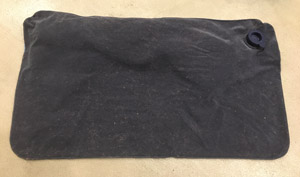
The interior foam liner of my cooling pillow insert became folded over on itself so that half the surface area was unusable.
Cooling Pillow #1: A Cooling Pillow Insert (Water)
The first cooling pillow’s design seemed reasonable enough. The concept is simple: you simply slide a plastic bag containing water, gel or other liquid into your pillow case on top of your existing pillow. There are several different brands and variations available, but most share the descriptive term, “cooling pillow insert.”
This was the cheapest cooling pillow option. I found a water-filled version for just 12 bucks. The bag is about 10×20″ and only about 1/2″ thick. One side of the insert has a soft flocked (textured) surface, which I assume is to help keep it from sliding around inside your pillow.
I didn’t notice it until I unscrewed the water filling valve, but the bag contains a thin layer of polyester foam. When filled, the foam layer absorbs and retains much of the water. This helps to prevent the water from sloshing around to one part of the bag like a water bed does.
There’s a bit of preparation required. Fill it up with warm water, push the air out, seal it and wait for it to cool off—easy enough. Once full, I was surprised by its unique texture. Thanks to the foam, it felt much more like a gel filling than water—very interesting!
To test the cooling pillow insert, I used a shredded latex pillow. It is a good representation of some of the most popular traditional soft pillows in terms of density and breathability, so I figured it would make a good test subject. I slid the insert into my pillow case, on top of the pillow itself, with flocked surface down so that it’d have a little grip and stay put.
The cooling pillow insert was initially impressively cool!
It does in fact keep your head and neck cool. When it sits alone unused, the water inside the insert drops to match the surrounding temperature, which depending on the environment, is around 75 degrees or so. Conversely, your body is a hot and balmy 98.6 degrees. So when you sink your head back into your pillow, it definitely feels cool. I was impressed.
Unfortunately, it doesn’t stay cool forever. The water slowly absorbs the heat from your body until an equilibrium is reached. Then the cooling effect stops. It felt cool for about a half an hour.
“No problem,” I thought to myself, “I fall asleep in less than half hour…”
I fell asleep on it. Unfortunately, it woke me up a few hours later.
While sleeping, the cooling pillow insert slid down to the front edge of my pillow. The plastic bag wrinkled up into an uncomfortable lump and it definitely wasn’t cool any longer. I threw it onto the floor and went back to sleep.
The next day I picked it up and noticed that the foam inside had gotten bunched up along one edge. It seemed impossible to straighten it back out without draining the water and poking around inside with a hook of some sort. The water refused to evenly distribute. The foam in the corner absorbed most of it, keeping it all on one side, effectively halving the usable surface area. You can see this in the photo above—only the top half of the insert has any water in it.
I tried it a second night, but after more listless sleep, I gave up on it. It was not worth draining the water, trying to reconfigure the foam and refilling. The reviews online confirmed that this was a common occurrence.
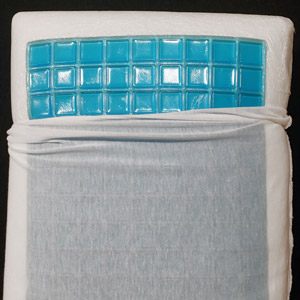
A cooling pillow with a gel layer
Cooling Pillow #2: Memory Foam Pillow with Cooling Gel
You’ve probably heard of memory foam pillows. While they can offer great support for your head and neck, they’re not particularly well-known for their ability to keep you cool due to a lack of breathability. Memory foam can be quite dense, restricting the ability of air to move freely throughout the pillow. Thus, they tend to absorb and retain your body heat.
This memory foam pillow, or “cooling gel pillow” as the manufacturer called it, promised to keep me cool. The concept is the same as with the water-filled cooling pillow insert. The gel layer’s temperature falls to match room temperature, and when you rest your head on it at night, the gel absorbs the heat from your head and neck.
Memory foam has a weird chemical odor.
The pillow came packaged in a zippered plastic bag. When I opened it, I was overwhelmed by a very powerful chemical odor. It almost smelled like mildew or mold. This was the most powerful smelling memory foam pillow I’ve come across. The documentation included with the pillow stated, “new foam products often have a natural and harmless scent or smell. Please air out before use.” I set it aside to allow the “natural” odor to dissipate. A week later, the smell has dissipated a bit, but is still obvious.
This “off gassing” of volatile organic compounds is a common and well-documented property of memory foam pillows and mattresses. The fumes are often compared to those experienced in a freshly painted room. Some of the chemicals used in memory foam aren’t entirely benign. The long-term effects of memory foam and its toxicity is not fully understood, but there clearly is some reason for concern. I believe that declaring off-gassing “natural and harmless” is deceitful.
Of the four cooling pillows I compared, the gel pillow was the least effective.
Initially it was cool, but that feeling did not last. In less than ten minutes, the heat from my head and neck quickly transferred to the gel layer and it warmed up to equalize with my body’s temperature. No more cooling 🙁 I opened the pillow to inspect the gel. The layer, attached to a solid loaf of memory foam, appeared quite thin—less than a 1/4″. It looked to me like there was simply not enough of the gel material to provide any effective or lasting cooling properties.
As a matter of fact, the cooling gel layer became counter-productive as soon as it warmed up. It restricts airflow, as the gel material is contained within an impermeable plastic layer (not that the memory foam beneath the gel was much more breathable). The fact that air cannot move through this layer prevents heat from escaping the pillow and moisture from evaporating.
Cooling ability aside, I didn’t find it very comfortable. The memory foam was a relatively solid, unmoldable loaf. It conformed to the shape of my head and neck, but I couldn’t quite position it the way I wanted. It’d always immediately bounce back to its original box shape.
Both the gel pillow and the water-filled cooling pillow insert only work for a limited time.
They quickly absorb the heat energy from your body. They’re cool initially, but the heat slowly builds up and stays inside. I found that once the cooling effect expired, it wouldn’t return until I removed my head from the pillow and let the cooling materials return to room temperature.
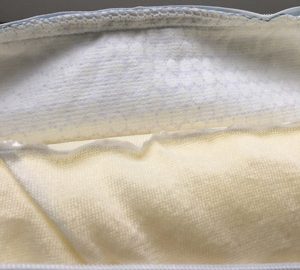
A memory foam pillow enclosed in a cotton PCM infused pillow case.
Cooling Pillow #3: A memory foam pillow with a PCM bead infused pillow case.
Yes, another memory foam pillow. Fortunately this one didn’t smell so much like an oil refinery. It was unique in that it came enclosed in a magical PCM (phase change materials) bead pillow case! Interesting…
PCM materials apparently absorb, store and release heat for optimal comfort. If you’re cold, it heats you up, if you’re hot, it cools you down. That sounds like marketing BS to me, but there’s apparently some legitimate science behind it. PCM technology was originally developed and tested by NASA.
If it worked for NASA, it must be awesome!
I slept on the pillow for several nights. It’s hard to say these PCM beads were in fact absorbing and storing my body heat in a way that kept me cool.
I had a lot of questions.
Didn’t the other products do essentially the same thing: absorb my body heat? Why is it good to “store” it, as opposed to transferring it out of the pillow to the surrounding air? At what temperature did the heat get absorbed and then released again? I had no clue.
It did seem more effective than the memory foam pillow with the gel layer. From what I could tell though, it wasn’t because of the PCM beads. I noticed that the memory foam fill in this pillow was much less dense than the the gel pillow’s. This one was considerably more squishy and seemed to offer a bit more breathability than the more dense material inside the gel pillow. I cut open the fabric liner to investigate the pillow filling. The foam was full of approximately 100 1/2 inch holes. These holes allowed air to pass freely through the pillow. This airflow provides a genuine cooling effect in that it prevents heat build up. Strangely, the product description made no mention of this feature.
I tried it both with and without the pillowcase and couldn’t discern any genuine cooling benefit offered by the PCM beads. The technology does seem to have real potential, but I sure couldn’t see it or measure it. Perhaps pillows are just the wrong application.
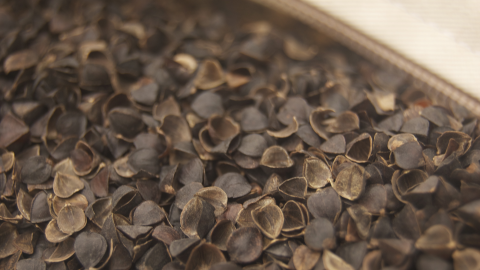
Buckwheat pillows allow warm air absorbed from your body to quickly escape, keeping you cool all night long.
Cooling Pillow #4: Buckwheat Pillow
Buckwheat pillows are filled with thousands of tiny buckwheat hulls. These are the byproduct of milling the buckwheat plant for its nutritious groats (most commonly used to produce soba noodles).
Buckwheat pillows are popular primarily because they provide excellent support for your head and neck. Their buckwheat hull filling’s unique character gives them the ability to shift and conform perfectly to the shape of your body. This allows the weight of your head to be evenly distributed, which will prevent any undue stress on the muscles in your neck and back.
Full disclosure: I already love buckwheat pillows! Several years ago a friend convinced me to try one out. Initially I was very skeptical; firm, hefty and sort of like a bean bag, it was totally unlike any pillow I’d ever tried. It was so different than the soft, squishy down pillows I’d grown up with that it took awhile to get used to it. After a couple weeks, I couldn’t sleep without it. Every other pillow seemed subpar. It was such an awesome pillow that I decided to manufacture and sell them myself.
Buckwheat’s cooling ability is a result of its breathability.
The unique shape of the individual buckwheat hulls allows air to flow more freely through the pillow. This allows warm humid air absorbed from your body to quickly escape the pillow, preventing uncomfortable heat build-up.
Buckwheat vs. the modern cooling pillows
Buckwheat pillows are cooler than other traditional pillow types like down, but I wasn’t so sure how well it’d stack up against these modern cooling pillows that were specifically designed for the task.
After a few nights on each of the different cooling pillows, I began to form some solid conclusions.
The buckwheat pillow is different. While it doesn’t feel immediately cool, like a bag of water, it doesn’t warm up like the other cooling pillows I tried. It stays a comfortable temperature no matter how long I’m on it. The others gradually seemed to become ineffective or worse, counter-productive.
“Sure, sure… How’d you come to these unbiased conclusions, Mr. Buckwheat Pillow Guy?”
OK, I understand your skepticism. I tried to be objective in my methodology for this review. You can argue that my data collection was sloppy (it definitely was!), that I’m biased (maybe a little!), but I feel pretty confident about the results.
I started out by simply sleeping on each pillow for a few days and recording my experience with each (as written above). My arbitrary interpretation of each’s pillows’ relative “coolness” would prove insufficient for a genuine comparison, however. Hopeful that I could gather some solid data from which to draw conclusions, I purchased an infrared thermometer and took lots and lots of temperature readings.
Initial Heat Absorption
The cooling pillows’ surface temperatures all started just above room temperature at 75 degrees. When I rested my head on them, the temperatures would steadily rise until capping at 87-89 degrees within 15 minutes. All of the cooling pillows except the water pillow insert were consistent this way (the water pillow took about 30 minutes).
Despite this consistency, the pillows each were noticeably different in their perceived coolness.
Subsequent Heat Retention
When I first tried recording temperatures, I noticed that I had to act quickly to get a consistent reading after removing my head from the pillows. The temperatures of each pillow dropped at noticeably different rates. Some seemed to expel the heat immediately, while others, like the water filled pillow insert, retained it for a very long time.
I did more temperature readings to test how long each pillow retained the heat absorbed from my body. I rested my head on each pillow for 15 minutes, allowing its surface temperature to warm to about 87-89 degrees. Then I removed my head and recorded the time it took for each to return to room temperature.
The buckwheat pillow was much more effective at transferring the heat energy absorbed from my body back out of the pillow than the other cooling pillow types. It absorbed the body heat at the same rate as every pillow except the water pillow, but it transferred that heat energy back out of the pillow to the surrounding air much more quickly.
The buckwheat pillow dropped to room temperature in just under two minutes, far more quickly than the other cooling pillows:
- 3.5 times faster than the pillow with the memory foam pillow with the PCM infused pillowcase (7 minutes)
- 5 times faster than the gel pillow (10 minutes)
- 45 times faster than the water pillow insert (90 minutes)
Cooling Pillow Conclusions
With the exception of the water pillow insert, the area of each pillow directly in contact with my body remained a consistent temperature. The perceived coolness seemed directly attributable to each pillow’s ability to transfer heat away from the pillow to the air surrounding it. The coolest feeling pillows simply did not retain the heat. As it turns out, breathable pillows are most effective at expelling excess heat.
Both the gel pillow and the cooling pillow insert were a disappointment. That said, their ability to provide quick powerful cooling relief does have an application. For those in need of immediate, or temporary relief, a water or gel filled device might be a reasonable option for you. If the device contains an adequate amount of liquid/gel, they will provide a quick and strong cooling sensation that other pillows can’t provide. The length of time that the device will be effective will depend on both its size and the room’s temperature. Once you exhaust its cooling function, I expect you’ll feel like me and your so-called cooling pillow will end up on the floor. These types of cooling pillow designs aren’t effective for an entire sleep cycle, thus I would not recommend either that I tested.
The PCM infused fabric pillow case was a genuine mystery to me. I fell for the high-tech sounding marketing lingo. The science sounded pretty neato, but I honestly couldn’t detect any perceived or measurable cooling effect. I wasn’t able to determine what was happening with regards to either heat absorption or retention, the magic of the PCM material. Where the PCM beads absorbing and storing heat in a way that kept me cool? I sure couldn’t tell. Being that the case, my conclusion is that it simply doesn’t work. Maybe NASA can make one for us that does!
The buckwheat pillow, the most breathable type, was the best cooling pillow. It kept me cool all night without gimmicks or weird science.
The modern alternatives to my trusty buckwheat pillow weren’t very impressive. Compared to a proven, simple, all-natural solution, they were all wholly inadequate. It was obvious to me both from my personal experience sleeping on each of the pillows and from the temperature readings I collected: the breathable buckwheat pillows kept me noticeably cooler thanks to the simple fact that air was able to circulate through the filling.
If you’re looking for a cooling pillow that really works, I strongly recommend a buckwheat pillow. Don’t take my word for it. Our customers’ reviews speak for themselves!
“I got this as a father’s day present from my wife and kids. Ever since I got it (it’s August now) I can’t recall having a single night where I was feeling hot and sweaty on my head. This alone has made Hullo be the best pillow I’ve ever owned.” –M. Sandoval, verified Hullo customer
I’ll be the first to admit that buckwheat pillows aren’t for everyone. Being quite firm, they can take some getting used to. If a firm buckwheat pillow is not an option you’re willing to consider, try shopping for “breathable pillows” rather than the not-so-effective alternatives I’ve reviewed here.
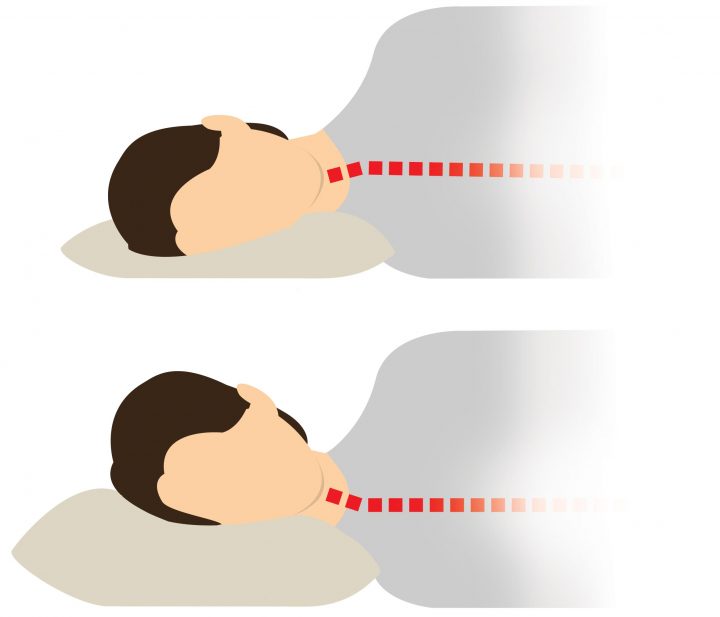
If your pillow doesn’t keep your head at the correct level, you may experience back and neck pain.
What’s so great about an adjustable pillow?
Consider the reason we sleep on pillows in the first place: they help to keep our head in neutral alignment while we sleep. Ideally your head should be perpendicular to your shoulders and your neck should not be bent too far in any direction.
Your pillow fills the gap between your head and the mattress below it, keeping your body consistently and comfortably aligned.
No single pillow is right for everyone.
It’s hard to find the right pillow. Sleeping with one that is too soft or thin will cause your head to lay too low, creating a downward bend in your neck. Conversely, using a pillow that’s too thick will create an upward bend. Neither is comfortable or conducive to restful sleep.
It’s simple: unnatural bends and twists in your spine can cause muscle strains and put pressure on nerves. Your spine is best off when it’s straight.

An adjustable pillow has the perfect loft, just for you.
An adjustable pillow isn’t too thick or too thin.
Pillows are often manufactured in a few loft variations, each specific to our sleep position. Side sleepers generally require a thicker, high loft pillow, while back and stomach sleepers are better of with low loft varieties. With an adjustable pillow, it doesn’t matter if you’re a side, back or stomach sleeper; it will accommodate all sleep positions and body types.
An adjustable pillow allows its fill to be added or removed so it can be dialed in to your personal preference. As long as the case has a zippered opening, you can add or remove whatever you want until you’ve perfected the pillow’s loft (thickness).
One thing to keep in mind—Some fill types like down and shredded latex can be very messy. For this reason, pillows containing these types of fill are only manufactured with a sealed, sewn-shut case. If you’re willing to do the unpleasant work involved with adding or removing messy fill, you can make your own zippered case and purchase the fill separately. If you’re not the do it yourself type, zippered pillow cases are also available at large retailers like Amazon.
Adjustable pillow types
Unfortunately gimmicks and misrepresentations are prevalent in the adjustable pillow market.

A layered pillow might be a convenient improvement over your sad old flat collapsed pillow.
Gimmick? Layer pillows are a little silly.
A new trend in adjustable pillows: so called, “layer pillows.” These are simply a stack of very thin pillows stacked and contained within a box-shaped fabric case. You add or remove the layers to make the loft appropriate for you and your sleep style. Most are filled with down alternatives made from rayon, polyester or cotton.
A layer pillows is probably going to be better for you than a traditional pillow that is too thick or thin. Unfortunately, its only genuine benefit is the convenience of adjustability. The downsides include:
- Each layer of the pillow restricts the fill contained. They prevent the fill from moving freely within the entire pillow’s form, so its shape is more or less constant and not moldable. It will not conform to the shape of your head like a non-layered pillow type.
- Down alternatives aren’t very effective at providing proper support for your head and neck. The weight of your head will compress the fill and make it thinner as you sleep. They require frequent fluffing to keep their loft.
- Finally, the multiple layers prevent air flow, each container potentially retaining your body heat. Nobody likes constantly flipping to the cool side of the pillow!
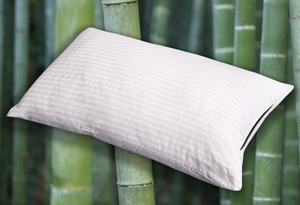
A bamboo pillow… err memory foam and viscose pillow
Misrepresentation? Bamboo pillows are not eco-friendly.
A good portion of the adjustable pillow market consists of so-called bamboo pillows.
Some contain a fluffy fill made from bamboo, but most actually contain memory foam, a potentially toxic material. These “bamboo pillows'” cases are made from a material called viscose, a type of rayon, which is derived from bamboo. It’s a popular fabric with a luxurious appearance—smooth and shiny, yet affordable.
Bamboo sounds like an environmentally responsible, safe component to use in a pillow. Marketers love to use the term bamboo, because it appeals to eco-conscious consumers. In reality, viscose rayon is pretty nasty stuff. It’s processed using using very toxic chemicals like carbon disulphide to turn it into useful fibers. Production results in the emission of hazardous air pollutants.
Bamboo pillows are not the happy eco-friendly products they’re made out to be. The FTC agrees: several large retailers were warned in 2009 about misleading bamboo claims.

An unzipped pillow reveals the buckwheat hull filling contained.
Adjustable pillows that are both comfortable and safe: buckwheat pillows
The best adjustable pillow option is, in my opinion, vastly under-appreciated. Have you ever slept on a buckwheat pillow? Despite having been around for centuries, most have never heard of a buckwheat pillow, let alone tried one.
A buckwheat pillow is:
- all natural and animal free.
- breathable and cool. The buckwheat hulls allow air to circulate freely all night long.
- super supportive, conforming perfectly to the shape of your head and neck.
Years ago, at a friend’s urging, I bought a buckwheat pillow and was so impressed that I started manufacturing and selling them. They’re amazing, but don’t take my word for it—check out these reviews from our customers.
A few other good adjustable pillow options
If you’ve already tried a buckwheat pillow and decided it wasn’t for you, there are other decent alternatives. I recommend you try:
Adjustable pillow or not, sleep on it.
While an adjustable pillow is a safer buy than a non-adjustable one, there is no substitute for literally sleeping on it. Squeezing a pillow inside plastic packaging at the store isn’t the way to find your ideal pillow. You really need to test drive them in your own bed.
Check the manufacturer’s return policy and make sure that you’re able to try it for at least a week. If it’s not right for you, toss it back in the box and return it. You spend a third of your life with your head resting on a pillow, so a little shopping and experimentation is absolutely worth it.
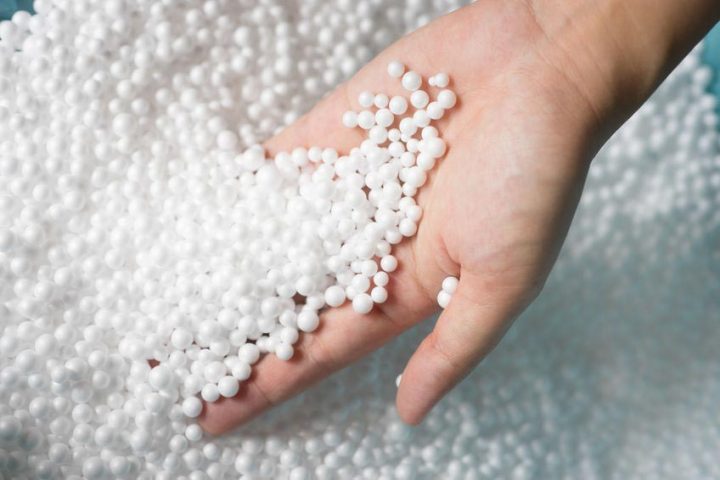
A handful of clouds… err… microbeads
Have you seen those late-night microbead pillow informercials?
Recently I overheard an exceedingly optimistic narrator on television say:
“A pillow 300 years in the making, based on the traditional Asian buckwheat pillow.”
The pillow that flashed on screen was filled with so-called microbeads. But it’s based on the buckwheat pillow?
I started a buckwheat pillow company many years ago, so I couldn’t resist ordering one of these things to see what the hell it was.
I went shopping online and noticed that some of the popular microbead pillows used the term “sobakawa,” which is japanese for “buckwheat,” in in their product descriptions, even though they aren’t genuine sobakawa pillows.
Buckwheat hulls (the hard outer shells that protect the buckwheat plant’s seeds) have been used as pillow filling for hundreds of years. Buckwheat hulls and microbeads are similar in that the individual pieces of filling are each approximately 3-4 mm in diameter. These tiny pieces work together allowing your pillow to be:
- moldable and supportive. You can shift the pillow’s fill to conform to the shape of your head and neck providing even and comfortable support.
- breathable and cool, retaining no heat. The space between the pieces of fill promote airflow, which keeps your head cool at night.
You could call microbeads a synthetic alternative to buckwheat hulls, but it’s a bit deceptive to use the term “sobakawa” to describe a microbead product that contains no buckwheat.
Microbead Pillow Pseudonyms
It turns out that most microbead pillow manufacturers don’t overtly employ the technical and often negatively perceived term, “microbead pillow” or “Japanese bead pillow” in their marketing materials. Thus, many consumers of microbead pillows have no idea what their products are actually filled with.
Why do they avoid the term microbead? It’s because the microbeads used in personal care products have have a less-than-stellar reputation.
They have been revealed to pose a serious danger to our environment. In fact, President Obama signed a bill that outlaws selling and distributing these products. Granted, the type of microbeads used in shampoos and toothpastes are a different type and obviously used for different purposes, but the negative connotation remains.
What is a microbead pillow filled with?
Most microbead pillows sold in the US typically contain tiny, spherical beads made of polystyrene foam, the same material used in packaging foam. Look at the image at the top of the page. It’s pretty hard to argue that a handful of that is anything but bad for the environment! It’s pretty yucky stuff that will sit in a landfill for hundreds of years.
It’s worth mentioning that there exists a distinct type of “microbead” filling, quite different from polystyrene beads. This alternative comprises hard plastic beads. Since I haven’t had the opportunity to test this variant, I can’t speak to their comfort. However, like polystyrene, it also poses environmental concerns.

Your microbead pillow will eventually end up here
Polystyrene beads unfortunately contribute significantly to municipal solid waste (MSW).
In 2018, plastics, including polystyrene, made up 12.2% of MSW in the United States, amounting to 35.7 million tons. This was a notable increase from previous years, highlighting the escalating issue of plastic waste.
The environmental impact is compounded by the fact that only a small fraction of these plastics is recycled. The vast majority ends up in landfills or, worse, in natural habitats where they can persist for centuries. This pollution poses threats to wildlife, particularly marine animals that may ingest these materials. Moreover, the production of polystyrene products release harmful chemicals into the environment, contributing to air and water pollution.
Efforts to combat plastic pollution include the Biden-Harris Administration’s draft “National Strategy to Prevent Plastic Pollution,” which aims to address the plastic lifecycle comprehensively and reduce environmental and public health impacts.
All these unfortunate realities are why companies often market microbead pillows under appealing names like “cloud pillow” or “air bead pillow.” That sounds better!
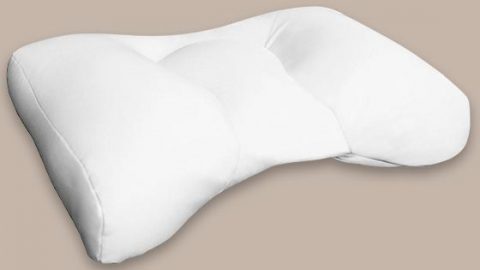
This microbead pillow’s sinister and foreboding silhouette is complimented with a heart of evil “air beads” that will destroy the earth for your children. Sleep well!
Microbead Pillow Initial Impressions
Lightweight
I actually wasn’t too sure what to expect until it arrived on my doorstep. A small, very light weight box arrived. I assumed the microbeads would be heavier, like hard plastic.
I opened the box and found an 18×12″ kidney bean-shaped pillow tucked in a plastic bag along with wrinkled xeroxed instructions. It felt lighter than traditional pillow fill types like down or even polyester.
I couldn’t see what was inside the pillow, but I was able to get a good sense of the fill’s physical characteristics through its thin fabric case. I recognized the small spongey white beads as being similar to what was inside many kids’ bean bag chairs. According to the company’s marketing materials the pillow contained 10,000,000 of them. I sure hope these vaporous little bastards never escape their case!
Design
The microbead pillow I purchased was unique. The pillow’s outer shell, or case contains the polystyrene fill in three separate compartments. The center compartment is slightly smaller to accommodate your head, neck and shoulders. The fabric appears to be some sort of a polyester blend. It’s smooth, almost “slippery” and unfortunately doesn’t look very durable. It was marketed as both a “microbead neck pillow” and a “microbead travel pillow,” which I assume is because it was considerably smaller than a standard size (20×26″) bed pillow.
The odd shape means you’re stuck using the funky white case it comes with. My wife hated it the moment she saw it sitting on her designer bedding!
Off-gassing: Are microbead pillows safe?
When I pulled my microbead pillow of its plastic bag it was immediately evident that these things stink! It smells like it’s full of caulk. The odor was incredibly distracting. I even found it concerning (is this thing toxic?). I’ve had it for over a month now and it’s admittedly less noticeable than it was when it first arrived. However, it still has a strong chemical odor that I find too unpleasant to use consistently.
“Although there is evidence that styrene causes cancer in animals, it has not yet been proven to cause cancer in humans. Styrene primarily exhibits its toxicity to humans as a neurotoxin by attacking the central and peripheral nervous systems. The accumulation of these highly lipid-soluble (fat-soluble) materials in the lipid-rich tissues of the brain, spinal cord, and peripheral nerves is correlated with acute or chronic functional impairment of the nervous system.” – Resources for Environmental Justice Activists
That doesn’t sound like something you should spend 1/3 of your life on.
FREE (?) Pillow Case
“As a special bonus, you’ll recieve one free pillow case” Hooray! The package included a specially fitted case for the pillow. It has a zippered opening and fits snugly over the pillow.
How to (not) Wash a Microbead Pillow
Reading the instructions made it clear why the pillow case was included: the pillow itself cannot be washed. The free pillow case is your only line of defense against stains and odors. The infomercial claimed that I would “… never need to buy another pillow…” That’s a pretty bold claim given that I can’t clean it.
There are two concerns in washing a microbead pillow:
- Its thin fabric case could easily come apart in the wash. It’d be a disaster to have all those beads clogging up your washing machine! The local nature would probably hold a grudge against you as well.
- A dryer typically will not get hot enough to melt polystyrene microbeads, but the heat can apparently affect their durability. A few trips to the dryer can render your microbead pillow a pancake.
The Verdict: Are Microbead Pillows Comfortable?
A microbead pillow starts off quite soft to the touch, but once you apply pressure, it becomes very firm. This firm support might be a bit of an adjustment for those used to the classic, softer pillows. I sleep on a traditional buckwheat pillow, so I appreciate the firm and even support that microbead pillows offer. You slide your head into the pile of microbeads and they’ll magically conform to your head and neck. Not bad!
Unfortunately, it’s not perfect: the smooth surface of the individual microbeads prevents them from gripping one another. The beads slide away from one another until the fabric case restricts their movement. As a result, a microbead pillow isn’t very good at holding its shape. You’re likely to end up repositioning it more often than you’d like.
The pillow’s three separate compartments are apparently required to prevent the fill from bottoming out.
Without them your head would likely sink too deep. Consequently, the microbead filling would all collect around your ears, providing woefully inadequate support. It’s actually similar to a millet hull pillow in this regard. Despite having separate fill compartments, my head seemed to sink too deeply into the pillow. The two side compartments pushed upwards on either side of my head making me feel somewhat claustrophobic.
After some use, the pillow is considerably thinner than when it arrived. All pillow filling types degrade over time and loose some of their loft, but this happened rather quickly. I slept on it for at least 3 weeks and my kids gave it some good abuse in their pillow fort. It seems that, with pressure, the microbeads’ shape degrades rapidly. They haven’t sprung back to their original shape.
As it happens, the pillow was initially too thick for me, but after some use, it has a more appropriate loft. I assume that with continued use, it’ll be far too flat. User reviews show this is a consistent problem with microbead pillow fill. Unfortunately, adding more to the case isn’t an option because it’s already sewn shut.
The real deal-breaker was the smell.
The strong chemical odor was not pleasant. It was a real distraction to me falling asleep. Some users have reported headaches that they attribute to the off-gassing of their pillows. I personally never felt any adverse affects like headaches. Still, I can’t help but wonder if it’s really safe to breath those fumes every night.
Microbead Pillow Pros:
- A microbead pillow is moldable and malleable. It’ll conform perfectly to the unique space between your head and mattress. Effectively eliminating all pressure points, the support provided is even and comfortable.
- It’s breathable. No flipping to the cool side of the pillow!
Microbead Pillow Cons:
- The potentially hazardous off-gassing from polystyrene is hard to ignore.
- The filling loses its elasticity and volume rather quickly. As a result, the pillow quickly flattens out with use.
- The individual microbeads don’t grip each other because of their smooth rounded edges. This causes the pillow to loose its shape, requiring frequent readjustment.
- The unusual shape of most microbead pillows prohibits the use of traditionally sized pillow cases.
I gave the microbead pillow an honest shot, but I couldn’t wait to return to my reliable buckwheat pillow.
Anyone who is considering a microbead pillow should first give a buckwheat pillow a try. A buckwheat pillow is more comfortable, safe for you and the environment, is more durable, and doesn’t smell like paint!
Don’t take my word for it, check out these honest reviews from our customers.

Turning quickly to confront a taunting seagull can result in a stiff neck.
There are many effective stiff neck remedies. Before you run down our list of useful solutions, first try to identify the cause of your discomfort. Did you turn your head too quickly while deflecting a seagull attack? Wake up contorted on some empty beer cans in your neighbor’s barn? Perhaps you were rear-ended in your golf cart…
If it’s obvious, just avoid those circumstances in the future!
The causes of a stiff neck are most often just a bit of bad luck and the associated discomfort only temporary. But if your stiff neck is persistent pain that isn’t obviously associated with any recent event, you might need some professional advice from a doctor.
Whatever the cause, a stiff neck can be really unpleasant and some quick relief is probably what you’re looking for.
Fortunately the ways to temporarily cure neck pain are reasonably consistent and simple.
Effective Stiff Neck Remedies:
1. Give your neck a break.
Your big ol’ head weighs about 12 lb. That’s a considerable amount of weight that your poor neck has to support all day. As with many ailments, rest is often the best remedy. Give yourself a little time off: lie down. Make sure your head in a neutral position and that you’ve got a comfortable pillow.
2. Avoid stressful situations (and clear your mind).
Are you worried that the government will discover you haven’t paid enough taxes? Nervous about the inevitable earthquake? Forget your problems with entertainment: turn on the TV and relax.
3. Ice Ice Baby!
Using ice to cool the affected area can reduce discomfort for some, but it can worsen a serious issue. If the pain intensifies, remove the ice immediately.
4. Ask for a massage.
Do you have a considerate friend who is willing to give you a neck massage? Cash in! Even if the relief is only temporary, a good massage usually makes life a little brighter in the moment!
5. Apply a hot compress.
A damp warm towel (use a microwave to heat it) can work to provide relief to a stiff neck. Remember that heat can make inflammation worse, so if your symptoms intensify, remove the it!
5. Try over the counter pain medication.
Acetaminophen and Ibuprofen can go a long way to providing temporary pain relief. Please follow the directions on the packaging!
6. Warm up and stretch your neck.
It’s always a good idea to take a hot shower or use a hot compress before stretching to avoid injuring yourself. The key is to not overdo it! Here’s 4 of the simpler neck stretches recommended by WebMD:
- Slowly turn your head to the left. With your left hand, apply very light tension on your chin so that your head turns slightly more. Hold for 20 seconds and return your head slowly to center. Repeat on the right side.
- Tilt your head to the left and try to touch your left ear to your shoulder. With your left hand, apply light pressure on your temple. Hold for 20 seconds and repeat on the right side.
- Bend your head forward and try to touch your chin to your chest. Relax the shoulders as you do this. Hold for 20 seconds and repeat.
- Lie on your back with your knees bent and a pillow under your head and neck for support. Nod your head forward gently, as though you were saying “yes.” Hold the position for 10 seconds and then relax. Repeat 10 times.
Consistent pain in the neck?
Remember, these stiff neck remedies are only temporary fixes! Those recovering from a seagull attack can try all of the above. But if you’re experiencing a stiff neck on a consistent basis, do something that addresses the root of the issue(s) rather than just treating the symptoms.
If you have some effective stiff neck remedies, please share them in the comments below!
Read More: Neck Pain From Sleeping Wrong? What You Can Do Right Now

This stomach sleeper quietly dreams, “%#&$! the PRESSURE on my discs, muscles and nerves is extremely irritating.”
Sleep experts agree: sleeping on your stomach is going to kill you!
Well, not really, but stomach sleeping is pretty rough on your sad, aging spine. Why?
Your spine is happiest when it’s aligned in what’s called a “neutral” position. Neutral alignment keeps all the bits and pieces in your back in in their ideal positions, preventing unnecessary pressure on your discs, muscles and nerves. Keep your spine neutrally aligned and you’ll avoid discomfort (or worse).
Unfortunately it’s hard to achieve anything resembling neutral alignment when sleeping on your stomach.
Lying on your stomach inevitably results in awkward bends and twists in your spine’s natural curves that can lead to discomfort:
- Most pillows force your neck into an uncomfortable upward bend
- Your hips may sink too deep into your mattress creating an unnatural downward bend in your lower back.
- Further exacerbating these contortions, your neck has to be turned ninety degrees to the left or right (you can’t breath into your pillow, after all).
All this unnecessary stress and pressure in your back and neck can result in pain that persists during the day.
You could learning to sleep on your side, or your back but…
What if you don’t want to stop sleeping on your stomach?
Let’s face it, changing your sleep position isn’t easy. We sleep the way we do for a reason; it’s comfortable (at least initially). If you’re set on sticking with your stomach sleeping routine, make the most of it with the following tips:
1. Eliminate the bend in your lower back.
The middle of your body is where you’re carrying most of your weight. Thus, your pelvis tends to sink into your mattress farther than your upper and lower extremities. This can cause the lumbar section of your back to fall out of its neutral position. Your hips may sit too low, resulting in unnecessary pressure on the discs, muscles and nerves in your back.
You can reduce the pressure in your lower back by:
- sleeping with a pillow under your hips. This will keep your pelvis slightly elevated off the mattress’s surface, helping to eliminate the excessive downward bend in your back. Experiment with the pillow’s height (loft). An adjustable pillow type that allows fill to be added or removed to your preference will make determining proper loft a breeze (more on that below). Admittedly, sleeping with a pillow under your waist can be a little awkward, so you should also consider…
- sleeping on a firmer mattress type. A mattress that is too soft (we’re looking at you, pillow top mattresses!) will often make lower back pain worse, as your pelvis will not get proper support. A new mattress is expensive of course, so we recommend that you first experiment with the pillow solution above. If that improves your sleep, you can make some reasonable assumptions about the benefits of a new mattress.
2. Try an adjustable pillow (or none at all).
Most traditional pillows are simply too thick for sleeping on your stomach; they’ll force your neck to bend upwards too far.
First, try tossing your pillow aside and sleeping without it. This can help keep your neck positioned more appropriately than using a pillow that’s too thick.
For most stomach sleepers, going sans pillow probably doesn’t feel right. If not, you’ll want to try a thinner, low loft pillow type. More specifically, you’re best off with an adjustable pillow that allows its fill to be added or removed via a zippered opening. This will allow you to fine tune it to your preferences so that it’s not too thin or too thick.

Child’s Pose for praying to the sleep gods (and stretching your back)
3. Relax for a bit in the “child’s pose” when you wake up:
- Sit with your shins to the floor, toes pointed backwards,
- push your pelvis downward,
- reach forward with both hands touching the floor and
- alternate your reach slightly from left to right to extend both sides your back.
Be careful not to overdo it. Pushing just a bit too far can easily result in injury.
Determined stomach sleepers can get their rest (hopefully).
If you can pull it off, we advise that you try adjusting to another sleep position. If you’re happy on your stomach, squeeze our tips into your sleep routine to maximize the rest you’re getting.
Got some good ideas of your own? Let us know in the comments below!
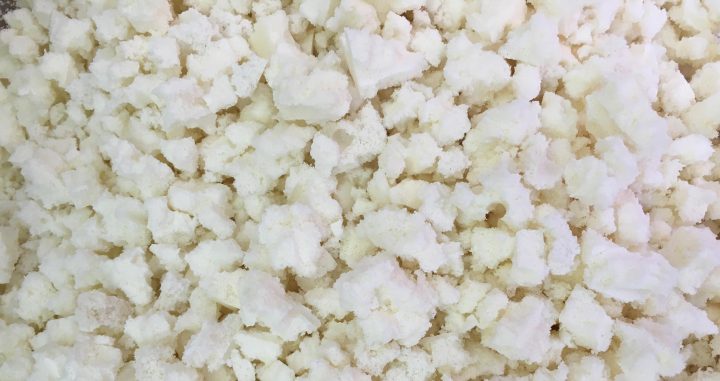 About a year ago I tried out a latex pillow. I had high hopes, as they’re generally very favorably reviewed. Unfortunately I was less than impressed. Mostly because it simply wasn’t malleable or adjustable — it was a single solid piece of latex molded into the static shape of a traditional rectangular pillow.
About a year ago I tried out a latex pillow. I had high hopes, as they’re generally very favorably reviewed. Unfortunately I was less than impressed. Mostly because it simply wasn’t malleable or adjustable — it was a single solid piece of latex molded into the static shape of a traditional rectangular pillow.
Not being able to change the shape of the pillow to fit my head and neck was frustrating and after sleeping on it for a couple weeks, it ended up in the closet. I just couldn’t make it comfortable.
While shopping for a latex pillow, I discovered that a small subsection of the market is devoted to “shredded” latex pillows. Shredded? As implied by the name, latex foam is fed through a shredding machine and ripped into tiny pieces.
Shredded latex pillows claim to be superior due to their adjustable and malleable nature.
The unpleasant experience with my previous latex pillow made me question if shredded latex was worth trying, but I decided to give it a go. Despite being a niche market, there were several different options available online. Ultimately I opted to buy only the fill.
I did so because I wanted to be able to adjust the amount of fill in the pillow to my liking (I was also very curious to know what shredded latex looked like). It’s pretty easy to accidentally buy a pillow with incorrect loft (thickness). Unless you get lucky with the right one, they’re either too thick or too thin. Fortunately, I had several extra Hullo pillow cases with zippered openings to experiment with.

Shredded latex is traditional foam rubber torn into tiny pieces.
I bought some shredded latex pillow fill online.
I’m not sure if it was the best quality available, but it wasn’t cheap: $55 for 5 lb. When it arrived, my kids and I tore into the box.
Inside was a large clear plastic bag full of what looked just like popcorn. The kids were disappointed to discover that it was not… I however, was more enthusiastic. I wanted to stuff it into a pillow case immediately, but I could tell that it was going to be a messy ordeal. The shredded latex consisted mostly of larger chunks about 1/2 in diameter, but a good deal of it was tiny, messy little rubber flakes.
I waited until the next day and took it outside, prepared with a scoop and a broom. It was a huge mess. I tried to keep the shredded latex contained within the bag I was scooping it out of, but it got everywhere.
Being the forgetful guy that I am, I left the bag out for my 2 year old to stumble upon. Thankfully he didn’t eat it. I’m still picking bits of it up weeks later. If you’re handling shredded latex, I recommend doing it somewhere where it’s easy to clean up. Keep it out of the grass and away from your rugs. It’s almost sticky, so you can’t easily sweep it up.
Anyway… mess aside, it took about 2.75 lb. to fill my standard size 20×26″ pillow case. That’s heavier than most traditional fluffy pillow types like down, but it was noticeably less bulky than my molded latex pillow of the same size which weighed 3.3 lb.
Zippered Pillow Case for Adjusting the Loft: Essential
It was a good thing I had a zippered pillow case. I found this to be crucial to attaining proper loft. Shredded latex is very spongy and its thickness varies substantially depending upon the pressure placed upon it. After a bit of tweaking, I was able to get the fill amount just right…
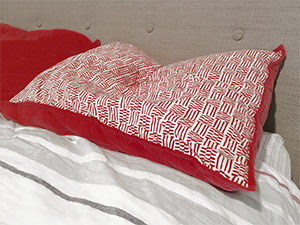
My shredded latex pillow was much more comfortable than the single-piece latex pillow I’d bought previously.
The best latex pillow? It’s definitely a shredded latex pillow
My initial impression was, “wow what an improvement!” I think its safe to say that, for most, a shredded latex pillow will offer far better rest than a molded latex pillow. For me, it was leaps and bounds more comfortable than the rubber log I’d tried earlier. The fact that I could smoosh it into the shape of my head and neck made a huge difference.
I spent a couple weeks on it and formed some solid impressions.
Shredded Latex Pillow Positives:
- It’s malleable! Unlike a solid single-piece latex pillow, you can squish this thing fit into the space between your head and neck so that you’ve got proper support.
- It’s a great alternative to products that inhumanely treat animals (down), or utilize potentially hazardous chemicals (memory foam). *Note: beware that many latex pillows contain a blend of latex and polyurethane foam. I recommend you look for shredded latex that is labeled “100% natural latex.”
- It’s quiet. Latex doesn’t creak, rustle or slosh. I’ve never been bothered by a little noise when my pillow is moved, but some find shifting fill distracting. Latex is perfectly silent.
Shredded Latex Pillow Negatives:
- It’s a little too soft. Too soft? Most people think that “soft” is a good quality in a pillow, but if your pillow is too soft it can cause or exacerbate neck pain. The shredded latex was so squishy that the loft (thickness) is hard to get just right. Sometimes it feels too thick and just as often, it’s too thin. If I shifted the fill just slightly, the pillow felt totally different. While it is certainly adjustable, it does take a little work to get it just right.
- It smells like a pile of rubber gloves. It’s an odor that doesn’t conjure a pleasant associations (dentist flashbacks triggered here). It’s hard to ignore the lingering odor of latex. It does not seem to go away quickly. I just pulled last year’s molded latex pillow out of the closet… The odor is as powerful as ever.
- This shredded latex pillow felt more breathable and thus cooler than my previous latex pillow, but it doesn’t compare to the airflow offered by my favorite, buckwheat pillows. I found that the shredded latex built up and retained my body heat. That said, it certainly offers better breathability than down or memory foam pillows. The thousands of small pieces of latex have an irregular shape that allows some air to flow between them. Flipping it over is the simple solution, but I prefer sleeping on the cool side of the pillow all night.
Other Observations:
- According to some online reviews, latex breaks down rather quickly compared to other pillow fill types. When it does, both the loft and support of your pillow will suffer. I’m unable to vouch for this claim, because I’ve only had it for a few weeks, but it seems reasonable to assume that even a slight change in its density or elasticity would change the feel of the pillow considerably.
- Is it machine washable? I found contradictory information online. I’d be scared to put mine into the washer, particularly because it has a zippered case. What if the fill came out of the case somehow? Tiny pieces of rubber in the plumbing sounds like a disaster. If anyone has experience with washing shredded latex pillows, please post your experience in the comments below!
Summary:
Shredded latex pillows are in my opinion, far superior to traditional molded latex pillows.
I’m surprised that they’re not more popular than they are. No pillow is perfect for everyone, but I think these would appeal to a lot of people.
Which shredded latex pillow is the best?
They’re all quite similar. Look for a high quality zippered case so that you can adjust the filling. I also recommend you look for products that are labeled “100% natural latex.” Many latex pillow pillow products consist of a blend of latex and other materials like polyurethane foam to cut down on cost.
For all a shredded latex pillow’s positives, I’m not a convert. The lack of consistent support was a deal-breaker. Sometimes it felt too thick and my neck was bent upward at an awkward angle, while other times it was simply too thin. Either way my neck didn’t appreciate it.
If you’re considering any type of latex pillow, be sure to check out my other review of a molded latex pillow. I discuss more of the specifics of latex foam including:
- how latex is made,
- the difference between natural latex vs. latex blends,
- latex’s exaggerated hypoallergenic claims
I’m not giving up my favorite: a Hullo buckwheat pillow. I’ve tried a lot of different pillow types, and nothing compares. Don’t take my word for it: read these customer reviews.
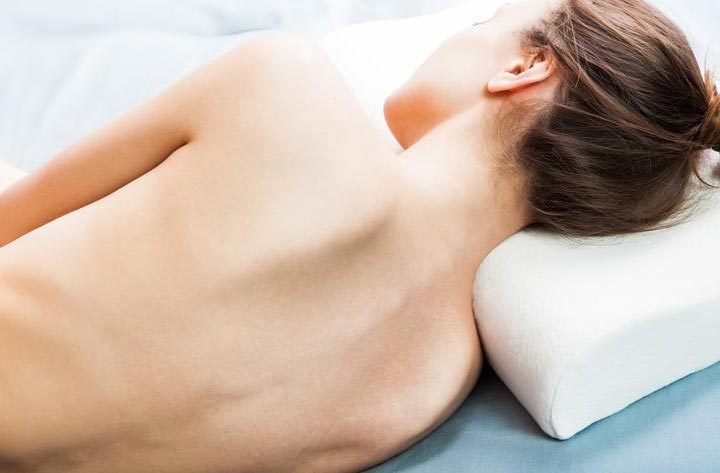
This pillow looks comfortable in this photo, but how about when she changes position?
Most traditional pillow types simply do not provide adequate neck support. A lack of proper support can cause neck, shoulder and back pain.
Traditional pillow filling may collapse under the weight of your head during the night, resulting in a uncomfortable downward bend in your neck. To compensate, people often stack 2 or more pillows, which can inadvertently create an upward bend in their necks. Both scenarios can strain muscles and/or pinch nerves, leaving you with aches and pains the next morning.
Suffering from sleep-related aches or pains? A neck support pillow might help.
Neck support pillows are designed specifically to help you achieve better sleep posture. They are meant to help your head, neck and back sustain a “neutral” position. Neutral alignment keeps all the bits and pieces in your back in in their ideal positions, preventing unnecessary pressure on your discs, muscles and nerves. Keep your spine neutrally aligned and you’ll avoid discomfort (or worse).
Most neck support pillows are rather unusual compared to traditional pillow types. They are often oddly shaped.
The predominant neck support pillow design is called a “contour” pillow. As the name suggests, contour pillows are modeled to the contour of a head and neck; most are shaped like a trough or a bowl, with a space cut out of the middle to cradle your head and a bulge at the edge to support your neck. These are typically made of synthetic poly foam, while more recently memory foam has become quite popular.
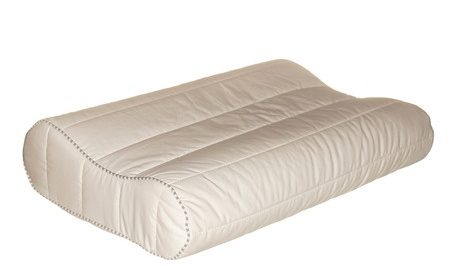
This type of neck support pillow is typically called a “contour pillow.” There’s no flipping this weird thing to the cool side…
There’s a problem with most neck support pillows.
1. Many neck support pillows are designed for a static sleep position; they’re not adjustable or malleable. Foam, latex and memory foam neck support pillows generally come in a predefined geometric shape. They’ll compress and conform to your head somewhat, but they cannot be shaped, fluffed or molded to support a variety of different sleeping positions.
Research shows that people change positions between 3 and 36 times during every sleep period. A preformed foam pillow is not optimally shaped for many of these positions. Thus, when you shift in your sleep, you’re not getting the proper neck support and potentially worsening any sleep issues you might be trying to correct.
2. Typical neck support pillows do not allow you to adjust the pillow thickness. Together, your body shape, the firmness of your mattress, and your sleeping positions make a unique space between your head and the mattress. Because this space is so specific to you, most neck support pillows don’t effectively keep your head properly elevated. This is simply because they’re not adjustable; they’re either too thick or thin.
If you’d like to try a non-adjustable neck support pillow, be particular about the loft. Try different models to find one that elevates your head to what you feel is best for you.
3. Finally, most neck support pillows are made from non-breathable materials, so they tend to retain the heat generated by your body. Additionally, their odd shape prevents most neck support pillows from being flipped to the cool side. More breathable pillow filling types will help keep your pillow cool.
No single pillow works for everyone.
If you’d like to try a neck support pillow, do it right. Squeezing a pillow inside plastic packaging at the store isn’t the way to find it. You really need to test drive them in your own bed. Check the manufacturer’s return policy and make sure that you’re able to try it for at least a week. If it’s not right for you, toss it back in the box and return it. You spend a third of your life with your head resting on a pillow, so a little shopping and experimentation is absolutely worth it.
A buckwheat pillow is a great alternative to a traditional neck support pillow.
Have your ever tried a buckwheat pillow? They’re sort of like a bean bag for your head. A buckwheat pillow is full of tiny buckwheat hulls, the byproduct of milling the buckwheat plant. The benefits of buckwheat pillows include:
- The irregular shape of these tiny hulls gives them a unique malleable quality that makes them superior to other pillow fill types. They’ll conform perfectly to the shape of your head and neck providing ideal support that’s just for you.
- Most buckwheat pillows have a zippered opening that allows you to adjust the thickness to your personal preference by adding or removing hulls.
- What’s more, there’s lots of free space between the individual buckwheat hulls so that air can flow freely through the pillow keeping it cool and dry even in the hot summer months.
Don’t take our word for it: read our customers’ reviews. We think you’re agree that Hullo buckwheat pillow is a terrific neck support pillow. Give Hullo a try for 60 nights and if you’re not satisfied, just ship it back to us for a refund.

We’ve all been there… you climb into your comfortable bed only to be rudely awoken in the middle of the night, your head cooking on damp, sweaty bedding. You flip to the cool side of the pillow and try to get back to sleep.
Repeatedly flipping to the cool side of the pillow isn’t the best way to sleep.
You crawl into bed for some quality rest and if you’re moving your pillow around… well, you’re not sleeping. The easy alternative is to crank up the a/c, but that of course, is a waste of energy.
You can flip to the cool side of your pillow all night, but it will continue to build up and retain the heat radiating from your body. Feather/down, polyester and other traditional pillow types all suffer from heat retention that can keep you from getting the best rest.
Why do pillows get hot? Generally it’s because they aren’t very breathable. Most pillow types’ fill restricts airflow causing your body heat to be trapped, quickly turning a comfortable pillow into a little oven for your head.
The market has produced some interesting solutions to the problem. Many of the “cool pillow” products available are useless gimmicks. Some require you to freeze your pillow during the day, others sacrifice support or worse. Others are covered with mysterious fabrics or contain liquid cooling gels. Most of these pillows do not specifically address the core issue: breathability. They do not allow air to move through the fill with any more ease than a traditional pillow.

A breathable pillow is a cool pillow.
The solution? It’s simple: a breathable pillow will keep your head cool.
If air is able to freely move through your pillow while you sleep, it will not retain the heat generated by your body. There aren’t too many fill types that are sufficiently breathable to make a pillow feel cool. One of the best: buckwheat hulls.
Buckwheat hulls are the byproduct of milling the buckwheat plant for its nutritious groats (most commonly used to produce soba noodles). The hulls’ hollow, irregular shape allows warm air to quickly escape your pillow, while being replaced with cool fresh air.

Cool & Comfortable Buckwheat Hulls
Buckwheat hulls’ advantage is more than its breathability.
Buckwheat hull pillows aren’t just cool, they can provide support for your head and neck that’s far superior to traditional pillow types. The buckwheat hulls’ unique character gives them the ability to conform perfectly to the shape of your head and neck. This allows the weight of your head to be evenly distributed, which will prevent any undue stress on the muscles in your neck and back.
The cool side of the pillow? Both sides!
What do I recommend? Our own Hullo buckwheat pillow of course! You can sleep on the cool side of the pillow without flipping it and it’ll give your head the best support it’s ever gotten.
What else will keep a pillow cool?
- Use a breathable pillowcase. Egyptian cotton with a plain weave (as opposed to sateen) works very well to promote air flow.
- Turn on a fan. Even a small amount of air flowing around you will prevent heat from accumulating inside your pillow and evaporate any moisture that accumulates on your body or bedding.
Read More: Does That “Cooling Pillow” Really Work? (4 Cooling Pillow Designs Compared)
Read More: How To Stay Cool In Bed Without Running an Air Conditioner

“Fiddlesticks… my back hurts! Was it last night’s keg stands or this old mattress?”
After a long night’s rest, you expect to rise feeling refreshed, ready to take on the new day. It can be a real downer waking up with back pain.
My back hurts after sleeping! Why?
The most common cause of sleep-related back pain is poor sleep posture. Thankfully it’s often simple to correct.
Poor sleep posture is typically the result of one of three things:
1. You’re just sleeping wrong!
We sleep 1/3 of our lives away. With that much practice you’d think we’d all be great sleepers. Unfortunately not all of us are getting the best rest we can get.
When you climb into bed, you might initially feel comfortable, but after you drift off, your sleep position can inadvertently put unnecessary stress on your back.
“But I used to sleep so well,” you say… Sleeping twisted up like a pretzel on a futon filled with hay and beer cans might have worked fine when you were 20. Unfortunately, as we age, the padded discs between our vertebrae wear out and we become more sensitive to our sleeping conditions. Time stinks. *sad trombone*
 Your spine is best off when it’s straight. It’s simple: unnatural bends and twists in your back can cause muscle strains and put pressure on nerves and discs. Keep your back and neck straight — you’ll potentially eliminate your back pain.
Your spine is best off when it’s straight. It’s simple: unnatural bends and twists in your back can cause muscle strains and put pressure on nerves and discs. Keep your back and neck straight — you’ll potentially eliminate your back pain.
Stomach sleeping is notorious for causing lower back pain.
In most cases stomach sleeping will cause your body to arch upwards. Hello, pain! It’s a good bet that this is the root of your problem. Try acclimating to a different sleeping position. Rolling to your side will be easiest for most stomach sleepers. A dense pillow under your top arm can simulate the feeling of the mattress under your chest.
If abandoning your cherished stomach sleeping position is just not feasible, try placing a pillow under your hips so that your lower back isn’t arched. Read More: Sleeping on Your Stomach: Make the Most of It!
Side sleeping can help to relieve back pain for some.
Side-sleeping works pretty well for most. It is the most common sleeping position and will help to keep your spine straight and elongated. Read More: Learn How to Sleep on Your Side
Back-sleeping, though not for everyone, can help as well.
Most doctors and sleep experts recommend sleeping on your back – if you can pull it off. Back sleeping can help you maintain a consistent and comfortable neutral sleeping position. There’s little opportunity for twisting or bending the spine, so back sleepers are likely to get better rest and wake up refreshed. Read More: Learn How to Sleep on Your Back (It Isn’t Easy)
Are you already a back sleeper and you’re still experiencing back pain? While it’s touted as a great way to sleep, back sleeping can sometimes cause back pain as well. If that’s the case, try putting a pillow under your legs and/or stretching your hip flexors before bedtime. Otherwise, try rolling to your side.
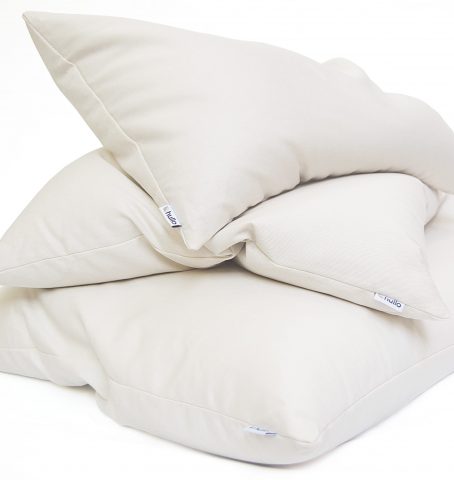
A new pillow can help improve your sleep posture.
2. It could be your sorry old pillow’s fault.
If your pillow is too thin or soft, your back will bend downward at an awkward angle. Conversely, if it’s too thick, your spine might bend unnaturally upward. Both situations can cause pain.
If your head is supported at the correct level, the muscles in your neck and back will be able to to completely relax. Pressure on your discs and muscles will be diminished and, as a result, your back pain reduced.
Most of us westerners are acclimated to traditional “soft” pillows containing down or polyester fibers. Traditional soft pillows will collapse under pressure and can not support your head consistently throughout the night. In fact, many find themselves using two pillows or folding their pillow in half in an attempt to support their head at the proper level. Fiddling with pillows in the middle of the night is not conducive to good sleep!
We are huge fans of buckwheat pillows due to their adjustable and malleable nature. The buckwheat hull fill is really unique—it will perfectly conform to the space between your head and the mattress eliminating potentially pain-causing pressure points in your neck and back. Most buckwheat pillows are adjustable; you can add or remove fill to dial in the loft (height) so that your spine is straight rather than bent upwards or downwards.
Your old pillow is probably pretty gross anyway! Toss it out and treat yourself to a new one.
3. Blame your expensive mattress.
Like pillows, your mattress needs to provide support that conforms to your body. The right mattress will help you maintain proper sleep posture all night.
Beware of the squishy pillow top mattresses!
Pillow top mattresses have become quite popular in recent years. They’re not necessarily better than non-pillow top types. Laying on a very soft compressible surface all night long can cause back pain for some, particularly stomach sleepers. These mattresses can allow your body to bend too far downward at the heaviest part, your waist. This can be a result of the pillow top’s filling:
- simply being too soft or
- sagging and/or compressing over time from repeated use.
Maybe your mattress is just too firm?
If your mattress is too firm, it won’t compress sufficiently to allow your body to sink downwards in the appropriate locations.
If you’re convinced that a new mattress is the key to eliminating your back pain, shop with caution.
The large mattress manufacturers are frequently criticized for their marketing practices. They often distribute the same mattress under different names to each retailer intentionally making it difficult for consumers to comparison shop.
Your best bet is to ignore the goofy marketing lingo and purchase whatever is comfortable and well-reviewed. Unfortunately it’s difficult to determine what’s genuinely comfortable with online shopping or even a short visit to a brick and mortar location. Ideally, you need to sleep on a mattress to truly know if it’s right for you. As it happens, many retailers now have generous return policies, making it feasible to try their products in your own home for a period of time. Before you make a purchase, make sure you understand the company’s return policy.
But my back hurts after sleeping and I need relief right now!
Spending money on new bedding or changing the way you sleep aren’t quick or easy solutions. Here’s a few things you can do for immediate pain reduction:
- Stretch your back muscles. Hamstrings, quads and hip flexors can shorten while sleeping. The simplest remedy for immediate back pain relief is good old-fashioned stretching. This WebMD video demonstrates five simple back pain stretches.
- Take a long hot bath. The warm water will help increase circulation and is often effective in providing relief to stiff muscles.
- No time for a bath? Use a warm compress instead. A warm damp towel (use a microwave to heat it) can work as well or better than a hot bath. Beware, heat can make inflammation worse, so if your symptoms deteriorate, remove that heat immediately!
- Ice in short increments. It can work well for some, but cooling can aggravate some more serious issues, so if the pain worsens, remove the ice immediately.
- Have a partner massage the affected area. Who doesn’t appreciate a good massage? Back pain or not, it generally makes life in the moment a little better.
- Pop a few of what modern medication has to offer. Aspirin, acetaminophen, or ibuprofen can help a lot if the pain isn’t too ridiculous. It should go without saying, but please follow the directions on the packaging.
Hopefully you’re able to pinpoint the source of your back pain and resolve it without too much inconvenience or expense.
If your back pain isn’t specific to sleep and persists during the day, you most likely have a more serious issue that cannot be resolved with the suggestions above. Go see your doctor if you aren’t able to some up with working solutions of your own.
Read More: What Are the Benefits of a Buckwheat Pillow?
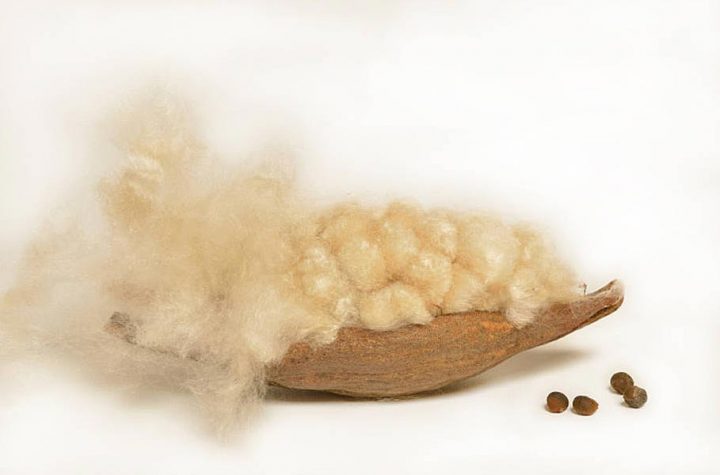
The flower and seeds of the kapok tree
Kapok, or ceiba pentandra, is a tropical tree native to Mexico. Kapok trees thrive in the rainforest grow to be quite impressive. They can be 200 feet tall with trunks as wide as 9 feet.
Kapok is a deciduous tree and drops its leaves following seasonal periods of heavy precipitation. While the tree is leafless, flowers appear. If they’re pollinated (most often by bats!), the flowers will produce a fluffy, cotton-like material containing hundreds of seeds. This light brown, soft fibre is sometimes called silk cotton or kapok cotton.
Kapok’s qualities have made it popular for filling pillows, upholstery, and even life preservers, but its use has dramatically declined since the introduction of synthetic polyester/polyurethane foams.
Kapok filling is currently experiencing a small revival thanks to its all-natural characteristics.
Kapok is an attractive alternative to other fill types like down, feather or synthetic foam because kapok is:
- free of the potentially toxic materials in many foam pillows.
- cruelty-free. The practice of gathering feathers and down for use in pillows is considered by many to be inhumane.
- a compostable and biodegradable resource that reduces waste.
Is kapok hypoallergenic?
Kapok fill is often marketed as being “hypoallergenic.” Unfortunately there is no regulation in the United States that defines or governs the use of the term, so manufacturers of all pillow types use the term quite liberally. Consequently, hypoallergenic claims often don’t carry much water.
It’s unclear how common genuine kapok allergies are because allergic reactions are often incorrectly attributed to kapok when the true cause is dust mites and/or mold. However, one study found that 10 patients out of 59 were allergic to kapok. Other studies show that kapok will accumulate dust mite allergens more quickly than other fibers. Given the evidence, calling kapok hypoallergenic is, at best, an overstatement.
That said, kapok can be an alternative for those allergic to other pillow filling types.

These smokers are about to catch their comfy new kapok pillows on fire. Sleep well!
Careful — kapok is flammable!
Unfortunately kapok is extremely flammable. Its flammability is partially to blame for its decline in popularity. If you’re accident prone and burning incense or anything else near your bed, kapok might not be a great pillow to have around.
While flammability is a viable concern, be aware that many traditional bedding products are treated with really nasty chemicals like formaldehyde to make them fire retardant. Is kapok’s flammability more of a concern than exposure to potentially dangerous chemicals? I would prefer kapok to a lot of the potentially toxic fire-retardant pillows currently available!
I ordered a kapok pillow and gave it a try.
I’d done plenty of reading about kapok, but I never tried sleeping on it. I researched a few different kapok pillows available on the internet and added one of the favorably-reviewed ones to my cart. A few days later, it was time to give kapok a whirl!
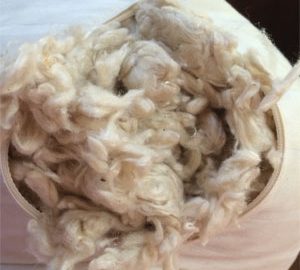
My kapok pillow with its zippered opening
When I opened the pillow, I examined the pillow’s filing carefully. It looked quite different from the stock image at the top of this page. The kapok was slightly clumped together in thick, light brown strands and a few small pieces of the seeds were scattered throughout. The clumps tear into smaller pieces easily, but the individual fibers attract and cling to one another giving it an interesting soft texture similar to raw cotton.
A deep inhalation of the kapok thankfully revealed no discernible odor.
It came with instructions: “How to wash your kapok pillow”
Unfortunately kapok stuffing doesn’t hold up too well in a washing machine. Much like wool, it’s prone to clumping and/or mold growth if not cleaned properly. Thus the manufacturer recommended to machine wash only the fabric case.
Intrigued, I slept on my kapok pillow for the first time.
Initially my new pillow was way too thick. The pillow pushed my head upward at an uncomfortable angle. No problem — it included included a zipper on the side, allowing me to remove some of the kapok to give it more appropriate, thinner loft.
As someone who’s accustomed to sleeping on a buckwheat pillow, kapok was an abrupt change for me. The kapok fill has a fairly uniform density and when compressed it tends to spring back into its original shape. Each night I’d squish and mash the pillow’s fill in an effort to mold it into a more comfortable configuration with little success. This soft loaf refused hold its shape.
Kapok is frequently compared to down. Down and kapok are both soft, but I found that the similarities ended there. I’d say that it’s more similar in texture and consistency to cheap polyester fiberfill. Moldability isn’t the only characteristic of a good pillow, so I shrugged it off and left it on my bed. I know from experience that its necessary to give a new pillow up to two weeks to get used to it.
Kapok Pillow Conclusions:
The lack of head and neck support bothered me. Inevitably, in the middle of the night, my pillow would shift and my neck would be elevated either too high or two low. Changing the amount of fill didn’t help. I longed for my faithful buckwheat pillow that perfectly filled the space between my neck.
After only a few days, I noticed that the kapok was starting to develop lumps, much like polyester foam or wool pillows do. For this reason, I imagine it will not last very long. I was surprised to see this happen so quickly because some of the marketing literature suggested that kapok resisted clumping. Regular maintenance with frequent refluffing might help to prevent this from happening.
After a couple of weeks of patient experimentation, I gave up. The kapok pillow ended up in my closet, alongside a growing pile of other pillow types.
Kapok pillows certainly have their advantages.
I think it’s a good choice for those that are looking for an all natural alternative to softer pillow types like down or polyester foam pillows. Not all, but some kapok pillows include a zippered opening, which is a big plus. This makes it easy to add or remove kapok so that you can adjust the loft (height) to your personal preference. You can’t do that with down pillows!
For me, the lack of moldability was the kapok pillow’s biggest flaw.
I just couldn’t make it stay in the shape I wanted and as a result I wasn’t getting the best sleep. Read some of the kapok pillow reviews at Amazon.com and you’ll find that it’s a common complaint. If you’re looking specifically for an all natural alternative to a soft pillow filling like down or polyester, kapok could be a good upgrade for you. It’s safe (as long as you keep it away from fire), doesn’t have any chemical odor and will provide roughly the same sleeping experience.
For most, I think that there are far better options
… like our own Hullo™ buckwheat pillow! Give one a try and I think you’ll agree that it’s superior to other pillow types. Don’t take my word for it — check out these customer reviews.
*Edit 7/13/2018* Two years after writing this, I felt it necessary to update this post. My kapok pillow still doesn’t get much use, but it does come out of the closet for an occasional guest or pillow fort. It has held up better than expected. It has proven itself to be more resistant to clumping than I initially thought.
